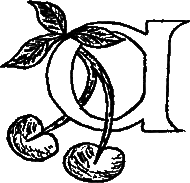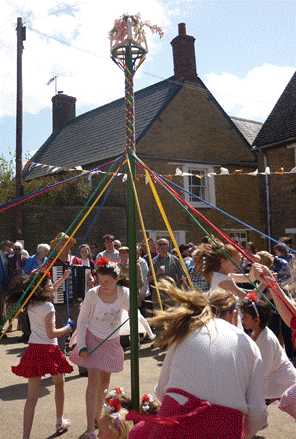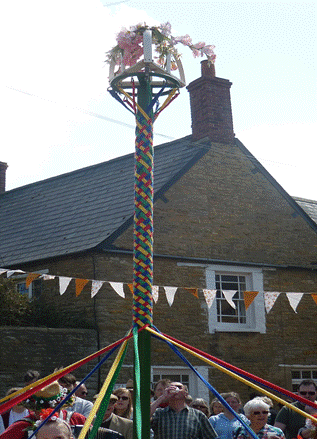
Apricot Folk - Maypole Dancing
Maypole Dancing Guide
Maypole Dancing - A Brief History
Maypole Dancing Guide THE MAYPOLE IN SCHOOL Some schools may have a ‘home-made’ maypole built in
the past by a friend of the school. These are very often a wooden post
inserted into a wooden base which may or may not be stable. Such
maypoles are often not easily transported meaning the school will not be
able to do any maypole dancing away from the school such as at village
fetes etc. Whatever maypole you have, it must be quite rigid when
erected and have a base large enough for 3 or 4 children (or weight such
as sandbags) to sit on while dancing is taking place. If children are sitting on the base, warn them not to spread their legs out (interferes with the dancing) and to keep their arms and fingers away from the base (risk of trapping fingers under the base if it lifts and then drops). |
  |
||
|
RIBBONS These should be about the same length as the pole (or slightly longer. By the time the children’s heights have been taken into account, this will give an ideal distance away from the pole. Ribbons that are too long are more difficult for the children to handle and make them dance a long way from the pole, resulting in patterns that are squashed up and not displayed well. Ribbons must be securely attached to the pole. A good way is to have a small loop at the end of each ribbon. The ribbon can then be attached to the ring on the pole by passing the ribbon back through the small loop leaving a larger loop at the free end for the dancer to hold. In this way ribbons can be quickly attached or detached from the pole if you vary the numbers of dancers in each dance. This is also a stronger way of fixing ribbons to the pole than by sewing a curtain ring to the end and attaching it to a hook on the pole. Children dancing round the pole will place a very heavy strain on maypoles and their fixings. There is no need for the TOP of the maypole to revolve. In fact it is better if it does not as most of the closed patterns such as Barber’s Pole will begin to form from the beginning of the dance. |
|||
 A secure way of fixing ribbones to the top |
 Another secure way of fixing the ribbons |
||
|
HOW MANY CAN DANCE? This depends on the dance. Most dances require dancers to have a partner and therefore need an even number. Some dances which work in 3s (Archangel, Jubilee Crown) could be done with a multiple of 3. Otherwise the minimum number is 8. This has the advantage that the patterns are easier to see and for the children to understand what they are doing as there are not too many other children to confuse the issue (or to go wrong) Children usually love maypole dancing so the problem will be you have more dancers than you need. In this case it is usually better to do a number of sequences with a smaller number of dancers (say 8 - 12) and swap children in rather than adding more ribbons to the pole. In any case, 12 is the best number to use for a 10ft pole. 16 is possible, but any more than this would be best accommodated using a taller pole. Using a tall pole creates other problems. The dancers will find the longer ribbons more difficult to handle and they will have to dance further away from the pole. This means they will have to travel further and therefore use up much more music to complete a sequence. If you have a very tall pole, it is probably best to fix the ribbons half way down, and not at the very top. |
|||
 Charlton Cherries dance 'Chrysanthemum' at the Charlton fete, 2006 |
|||
|
WHAT MUSIC CAN WE USE? Although there is recorded MUSIC available, any country dance music can be used to accompany maypole dancing. Most country dance tunes last longer than it will take for one maypole dance. You can of course fade out the music when you come to the end of the dance. Children look best when skipping round the maypole, so it’s best to choose jigs in 6/8 time, though as a contrast they can step-hop to a 4/4 tune. In the dance descriptions here, reference is made to the number of bars each movement should take. It is not essential these should be adhered to and the dancing can ‘cut across’ the music. However, for display purposes, it looks better to try and fit the movements to the music. There are 2 steps to each bar of music, so if you want to teach the children the number of steps to take, double the number of bars. (4 bars = 8 steps). Finally - there is a link to recorded music for each dance on the appropriate page. This will be for winding up, a short pause, and then unwinding. The music is an accordion playing mainly Playford 17th Century style tunes |
|||
 Croughton School dance ’Barber’s Pole’ at Bicester in 2014 |
 Charlton Cherries dance ‘Honeycomb’ at Aynho in 2014 |
||
|
WHO CAN DANCE? Maypole dancing can, of course be done by anybody, but adults will find it quite tiring. This is because when dancing round, great distances have to be covered in a short space of time and there are usually no pauses in the dances for individuals to rest. However, we have done maypole dancing with adult groups such as WI and when combined with a talk on the history of Maypole Dancing, they have enjoyed walking the dances through to the music. Most children enjoy maypole dancing as it is quite spectacular. We have worked with nursery children who can cope with circling the maypole and going in and out. They also like to stand and wave the ribbons up and down side to side or in a circular (windmill) motion. KS1 children will enjoy simple dances such as Barber’s Pole and Chrysanthemum. They can also dance as partners of an older child in dances like Double Plait or as non moving ‘gateposts’ in dances like Jubilee Crown and Spiders Web. Older children enjoy the sense of achievement in performing more complicated dances such as Single Plait and unwinding it successfully. |
|||
 |
|
 |
|
| Charlton Cherries dance ‘an impressive ’Single Plait’ at Aynho in 2015 at Aynho in 2014 | |||
|
TUNES WE HAVE USED FOR THE MAYPOLE DANCES ARCHANGEL The Doldrum BARBER’S POLE Grandfather’s Pet/Long John’s Wedding BASKETWEAVE Namptwich Fair CHRYSANTHEMUM Dargason/Bung Her Eye DANCING ON & OFF Come Lasses and Lads DOUBLE PLAIT Seabird/Lass o’ Killiecrankie GYPSIES’ TENT Step Stately HONEYCOMB Floral Dance/Portsmouth JACOB’S LADDER Juice of Barley/Upon a Summer’s Day JUBILEE CROWN Picking Up Sticks/Whirligig SINGLE PLAIT Fandango/Queen’s Jig/Greensleeves SPIDER’S WEB Liliburlero THE ROPES Billy Boy/Darby Kelly THE TANGLE When Johnny Comes Marching Home/ Derby Ram TOTEM POLE various Nursery Rhymes |
|||